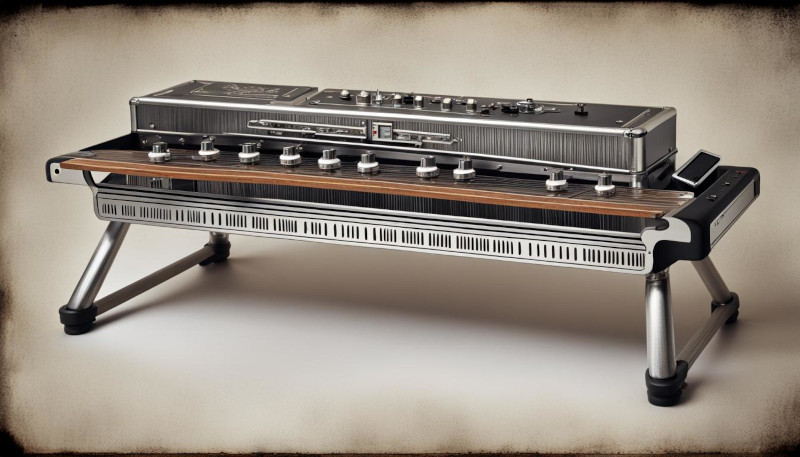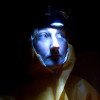By Blaize M. Kaye
My tab beeps and vibrates. There is a message from my Fotobot, the subject: “New Slideshow: Good Times!”
The Fotobot is, according to the manual, a “state of the art machine learning driven photographic curation program.” It digs through your photos to remove red-eye, fix blurry images, and tag people whose faces it recognises from your social networks.
It has recently learned to compile slideshows.
I tap on the message and my tab opens to a video. A simple electronic tune plays over a black screen which fades into a picture of Julie and I on a beach. New Year’s Eve, 1999, our first vacation together. It’s early in the night and we’re sitting near a driftwood fire. She has her feet buried in the sand.
Machine learning algorithms can recognise the same face over a range of ages. They can recognise that under the weight and the wrinkles, and despite the fact that I no longer have a full head of hair, I’m the same person as the young man in the picture. A young man, barely out of high school, sitting on a beach with the most beautiful woman he’d ever met.
After a moment, the image changes. Now it’s Julie and I at a party. Our housewarming. She’s wearing a short yellow dress and is drinking cheap wine out of a champagne glass. I’m drinking beer and am in a black t-shirt and khakis.
Machine learning isn’t only able to recognise faces, it can also infer emotion and mood. This is how the Fotobot was able to analyse this picture of us and determine — perhaps from the arch in her eyebrows, or the contour of my lips— how happy we were in our small apartment. Despite the fact that all we owned was a hand-me-down mattress and busted couch, despite the fact we were broke, the Fotobot could still infer that we were happy.
Another image. Now we’re in front of the Colosseum. We saved up for more than a year to visit Rome. She’s wearing a purple skirt and white blouse, I’m in a white t-shirt and jeans. There’s the slightest touch of grey in my hair. My left arm is draped over her shoulder.
The picture changes. Now it’s Julie and I inside a mirrored elevator on the day we met Ashleigh. Julie’s holding her swollen belly and is taking a photo with her free hand. I’m standing behind her, grinning widely, arms laden with bags and blankets.
The soundtrack picks up the pace. The images change quicker now.
Julie and me seeing Ash off on her first day of school. The three of us at lunch at a friend’s house.
Julie in a long red dress, her hair up.
Now a soccer match.
Now a graduation ceremony.
Now another wedding.
Julie. Me. Ash.
A whole life.
Oh, my girls.
Oh, my Julie.
The slideshow ends with Julie and I sitting together in the shade on a stone bench. It’s one of the last photos I have of us together. She’s wearing a wide brimmed hat and has a thick blanket over her legs. Ash is behind the camera while Julie’s wheelchair is just outside the frame, as are the tents of the makeshift neuroplague treatment centre.
I wonder about the machine learning algorithms that drove the Fotobot to compile this slideshow. I wonder about these algorithm’s practical limits, and the inadvertent algorithmic cruelty of those limits.
They can detect the smiles in the two faces sitting quietly together on a late autumn afternoon.
But, can they detect that I was trying to smile for her? Can they detect how desperately I was trying to smile for her? The music resolves to silence. The image of us on the bench blurs and the Fotobot icon appears, along with a message inviting me to “Start over from the beginning?”
I choose “Yes.”
![]()
About the Author
Blaize M. Kaye
Blaize is a writer and programmer from the Kāpiti coast, New Zealand.
His work has appeared in Omenana, Nature, and Strange Horizons, among other venues.

















 Geraldine Borella writes fiction for children, young adults and adults. Her work has been published by Deadset Press, IFWG Publishing, Wombat Books/Rhiza Edge, AHWA/Midnight Echo, Antipodean SF, Shacklebound Books, Black Ink Fiction, Paramour Ink Fiction, House of Loki and Raven & Drake
Geraldine Borella writes fiction for children, young adults and adults. Her work has been published by Deadset Press, IFWG Publishing, Wombat Books/Rhiza Edge, AHWA/Midnight Echo, Antipodean SF, Shacklebound Books, Black Ink Fiction, Paramour Ink Fiction, House of Loki and Raven & Drake Sarah Pratt is an avid fiction writer and a Marketing Consultant.
Sarah Pratt is an avid fiction writer and a Marketing Consultant. My time at Nambucca Valley Community Radio began back in 2016 after moving into the area from Sydney.
My time at Nambucca Valley Community Radio began back in 2016 after moving into the area from Sydney. Margaret lives the good life on a small piece of rural New South Wales Australia, with an amazing man, a couple of pets, and several rambunctious wombats.
Margaret lives the good life on a small piece of rural New South Wales Australia, with an amazing man, a couple of pets, and several rambunctious wombats. Mark is an astrophysicist and space scientist who worked on the Cassini/Huygens mission to Saturn. Following this he worked in computer consultancy, engineering, and high energy research (with a stint at the JET Fusion Torus).
Mark is an astrophysicist and space scientist who worked on the Cassini/Huygens mission to Saturn. Following this he worked in computer consultancy, engineering, and high energy research (with a stint at the JET Fusion Torus). Alistair Lloyd is a Melbourne based writer and narrator who has been consuming good quality science fiction and fantasy most of his life.
Alistair Lloyd is a Melbourne based writer and narrator who has been consuming good quality science fiction and fantasy most of his life. Ed lives with his wife plus a magical assortment of native animals in tropical North Queensland.
Ed lives with his wife plus a magical assortment of native animals in tropical North Queensland. Barry Yedvobnick is a recently retired Biology Professor. He performed molecular biology and genetic research, and taught, at Emory University in Atlanta for 34 years. He is new to fiction writing, and enjoys taking real science a step or two beyond its known boundaries in his
Barry Yedvobnick is a recently retired Biology Professor. He performed molecular biology and genetic research, and taught, at Emory University in Atlanta for 34 years. He is new to fiction writing, and enjoys taking real science a step or two beyond its known boundaries in his Sarah Jane Justice is an Adelaide-based fiction writer, poet, musician and spoken word artist.
Sarah Jane Justice is an Adelaide-based fiction writer, poet, musician and spoken word artist. Emma Louise Gill (she/her) is a British-Australian spec fic writer and consumer of vast amounts of coffee. Brought up on a diet of English lit, she rebelled and now spends her time writing explosive space opera and other fantastical things in
Emma Louise Gill (she/her) is a British-Australian spec fic writer and consumer of vast amounts of coffee. Brought up on a diet of English lit, she rebelled and now spends her time writing explosive space opera and other fantastical things in Merri Andrew writes poetry and short fiction, some of which has appeared in Cordite, Be:longing, Baby Teeth and Islet, among other places.
Merri Andrew writes poetry and short fiction, some of which has appeared in Cordite, Be:longing, Baby Teeth and Islet, among other places. Tim Borella is an Australian author, mainly of short speculative fiction published in anthologies, online and in podcasts.
Tim Borella is an Australian author, mainly of short speculative fiction published in anthologies, online and in podcasts. Chuck McKenzie was born in 1970, and still spends much of his time there.
Chuck McKenzie was born in 1970, and still spends much of his time there.